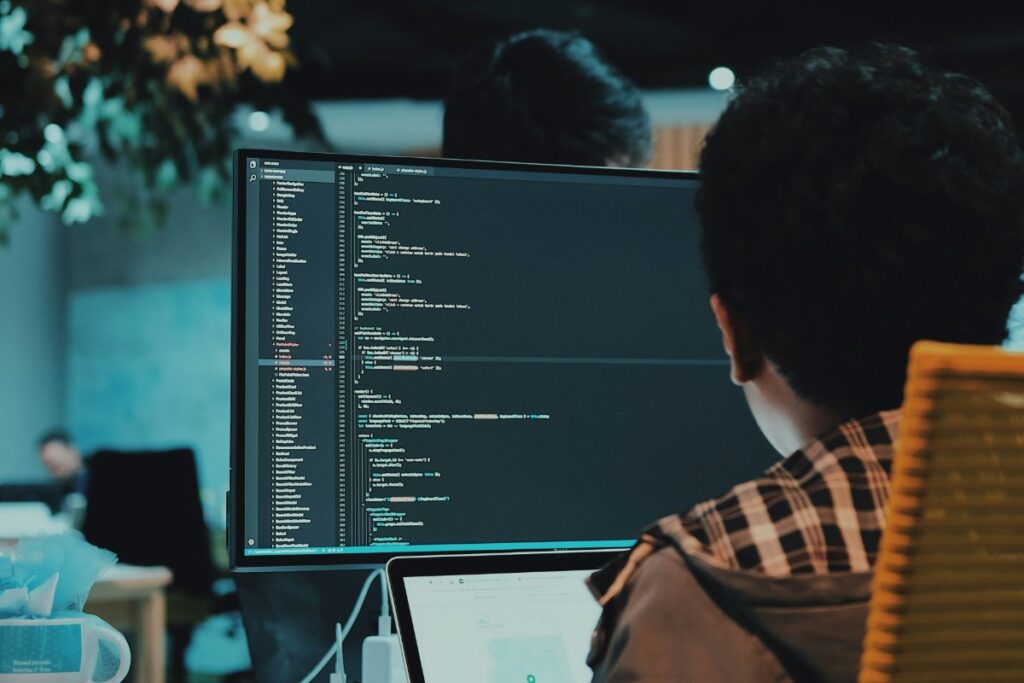Remote work has long been the luxury of units and the norm for most IT professionals around the world. The new Technology for Remote Work not only provides the potential to work from anywhere, but do it as conveniently, effectively and securely as can be.
A stable Internet link, cloud solutions, communication, and collaboration tools and automation of monotonous tasks – all this not only simplifies remote labour, but also increases teams’ productivity, saving time and organizational resources. Without technology, remote work would not have reached the heights that can be seen today: frictionless collaboration across continents, asynchronous communication, and instant access to information from all over the world.
In this article, created by Celadonsoft, that just explored the topic of Augmented Reality Applications and Innovations, we will examine which technologies have played the most crucial role in transforming remote work, how they help overcome challenges and what benefits they bring to businesses and professionals.

Evolution of remote work: from exception to routine
Remote work ten years ago was an exception rather than a rule. Either freelancers or companies ready to experiment practiced it. Now, distributed teams are the standard for the IT industry, and remote working formats are a digital integration part of corporate culture.
How technology changed the rules of the game
Previously, telework was hindered by technological limitations. Slow internet bandwidth, data security concerns, lack of good tools for teamwork – all this made the remote mode inefficient and tiresome. But since the emergence of cloud technologies, high-speed internet and specialized services for team management, the situation is different.
Today, the synchronized work of a distributed team becomes achievable owing to:
- Cloud services that provide real-time data exchange and instant project management.
- New communication forms – video calls, messengers, corporate social networks replace regular office meetings.
- Task management systems automating processes, making them more controllable and transparent.
Why the IT sector has become a driver of remote work
Technology firms like Celadonsoft were at the forefront of adapting to the new format, since their most valuable resource is people and their minds, not property. Flexible schedules, working from anywhere in the world, and the ability to tap into talent without geographic limitations made remote a logical step for tech teams.
Today, distributed teams develop software, support complex IT infrastructures and even implement DevOps best practices without needing to be physically present in the office. And those businesses that quickly adapted their processes to this format have gained a competitive advantage – access to the global specialist market and a reduction in operational costs.
Remote work is no longer an option – it’s the norm. And Technology for Remote Work just continues to drive it, with new opportunities for productivity and efficiency.
Key technologies that have transformed remote work
Remote work today is not just a convenient mode, but an entire work environment that requires robust tools for efficient collaboration. IT organizations are particularly looking for technologies that offer process transparency, efficient collaboration and high level of security. Consider the key solutions without which remote work would be impossible.
Collaboration tools online: work together, even remotely
Slack, Microsoft Teams, Zoom, Google Meet – these are today’s standard of business communication. They replaced hallway talks and negotiations in the process, providing teams with simple means of communication: chat, video calls, voice messages and support for other services. The more refined the processes in such applications are, the faster the decisions are made, and the less data is lost.
Cloud storage: unlimited access to data
Dropbox, Google Drive, OneDrive, and business products like AWS S3 allow you to upload files to the cloud and retrieve them any time, any place, any device. It is not only necessary to upload files into cloud but also taking care of management of access, document versions, security features to keep data protected.
Project management systems: managing processes without chaos
Jira, Trello, Asana, ClickUp – not just «task-boards», but complete systems of process management. In IT-teams, especially in software development, these tools make it possible to tidy up the work: distribute tasks, monitor status, check productivity. Automatic notifications and reports don’t let you miss key deadlines and unnecessary meetings.
VPN and Security: Data Protection during Remote Work
One of the remoteness challenges is data security. VPNs (virtual private networks) are the new standard for safe connection to business infrastructure. In addition to VPN, IT companies are working seriously on two-factor authentication (2FA), Zero Trust Security and password managers like Bitwarden or 1Password to minimize the leakage threat.
Technology for Remote Work is a non-detachable part of working remotely. The right choice of tools is not only dependent on the ease of employees, but also on the efficiency of the business overall. Those businesses that invest in smart solutions create a competitive edge by providing their personnel with a comfortable and productive workspace.
Artificial intelligence and automation: new productivity frontiers
Nowadays, advanced IT companies do not present their business without artificial intelligence and automation. These technologies, besides making work go faster, also help reduce the intellectual burden on employees, freeing them for more significant and creative tasks.
- Optimization of business processes with AI: Artificial intelligence does a lot of routine work. For example, customer service is automated using chatbots and voice assistants, and intelligent algorithms help in analysing big data with the assistance of pattern and outlier identification. In the AI-solutions division, processes are optimized: from auto-prioritization of tasks in project managers to forecasting deadlines for work based on historical data.
- Automation to reduce routine: One of the key advantages of automation is elimination of repetitive operations. For example, CI/CD tools (such as GitHub Actions, GitLab CI/CD, Jenkins) allow developers to deploy and test code instantaneously, minimizing the possibility of errors and enabling faster new releases. Automated management of infrastructure (Terraform, Ansible) in DevOps helps IT personnel spend fewer hours on server configuration routine work and more on strategic work.
- AI and automation in command control: It is not just technical work that benefits from the application of new technologies, but administration as well. AI Analytics helps identify team overloads, predict employee burnout and even in scheduling of meetings for optimization to avoid wasteful appointments and increase productivity.
AI and automation are becoming indispensable helpers of distant work. They minimize drudgery, reducing the time needed to perform tasks and making the team more efficient. Companies that already employ these technologies in their work today have the upper hand: their employees are less fatigued, processes get more efficient, and business productivity only grows.
Remote work technology adoption advantages and disadvantages
Technologies have made remote work easy and efficient, but companies are facing new challenges at the same time. Let’s consider the key benefits and potential issues IT teams face when a switch to remote.
Advantages: How technologies make it easier to work more efficiently
- Comfort and flexibility: Remote format allows the employees to work in comfort, increasing satisfaction and motivation. Because of tools such as Slack, Zoom and Notion, the teams are constantly in touch with one another, and processes do not get interrupted.
- Automation of redundant tasks: The more tasks that are automated within tools, the more time is available for strategic work. Customer support bots, CI/CD-Plugins, and AI-Assistants – all reduce the workload from developers and increase productivity.
- International access to the talent pool: Using the remote mode, companies are able to hire specialists globally, without geographic boundaries. This leads to more competition from the candidates and allows the company like Celadonsoft to obtain the skills they need sooner.
- Reduction of operating costs: Remote to business implies lower office, power, and transport expenditures. Many firms today invest in cloud Technology for Remote Work and security instead of renting offices.
Calls: What’s stopping you from working remotely?
1. Cybersecurity under siege
As work from home continues to rise, companies are now more vulnerable to attacks. The use of personal devices, exposed networks and phishing attacks all contribute to the vulnerability. To keep your data secure, companies utilize VPN, Zero Trust tactics and two-factor verification.
2. Communication problems
Without face-to-face communication, there are delayed processes and disconnection of the employees from the group. Proper setup of asynchronous communications, conducting regular meetups and the use of tools like Miro for group work is crucial.
3. Burnout and blurring of boundaries between work and personal life
When remote working, it is easy to forget the work-life balance. Employees can redo or, alternatively, struggle with self-discipline. Solution – implementation of clear procedures, for example, pre-specified time slots for work, breaks and provide mental well-being.
4. Ongoing training requirements
Technology for Remote Work is evolving rapidly, so workers need to master new software. Companies that invest in training (classes, webinars, in-house training) are more agile and competitive.
Future of telecommuting: trends and forecasts

Technology continues to rapidly transform the way remote commands communicate. In the next several years, we expect significant changes in tools and workflows that will render remote work even more productive and convenient.
- Immersive technologies: AR and VR in workflows: Augmented (AR) and virtual reality (VR) are no longer the sole domain of the gaming industry. More and more companies are trying out the technologies to hold remote meetings, training sessions and virtual offices. Imagine you’re wearing a VR headset, and you’re in an office environment with colleagues where you can not only communicate, but also share and manipulate virtual work objects. This format can eliminate one of the greatest disadvantages of remote work – lack of personal interaction.
- New communication platforms: Beyond Slack and Zoom: While tools like Slack, Zoom, and Microsoft Teams have become standard, solutions are now enabling even smarter and more agile ways of communicating. In the future, communication platforms will actively use artificial intelligence to automate the drudgery – from schedule planning to uncovering relevant discussion and content.
- Evolution of the corporate culture: less control, more trust: Businesses are gradually but steadily moving away from micromanagement to employee autonomy over the last several years. As performance metrics and task monitoring tools improve, it is becoming ever easier for employers to evaluate work results rather than time spent “online”. This will mean even more flexibility in schedules and work styles.
Conclusion: Technology as the foundation of successful remote work
Remote work is no longer viewed as a temporary solution – it’s a new reality that continues to evolve. Companies that proactively embrace the latest technologies not only boost the productivity of their teams, but also make the work environment more pleasant, drawing the best professionals from around the world.
But good remote work isn’t a tool set. It is a good process organization strategy, being flexible in learning new tools and trust-based, outcome-oriented culture, not control.
The future is hybrid and remote teams, and technology will play a significant role in deciding how businesses can operate well in this new world.


